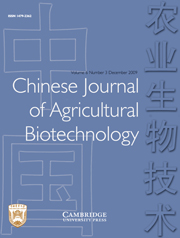No CrossRef data available.
Article contents
Identification and structure analysis of three tilapia species using microsatellite markers
Published online by Cambridge University Press: 30 October 2009
Abstract
Seventeen special loci were selected from 77 microsatellite markers to distinguish three varieties of tilapias, including the six differential loci UNH636, UNH117, UNH172, UNH738, UNH878 and UNH896 in Oreochromis aureus; five differential loci UNH913, UNH907, UNH222, UNH980 and UNH880 in O. niloticus; and six differential loci of UNH876, UNH899, UNH853, UNH932, UNH933 and UNH773 in O. mossambicus. Any one of the 17 loci could amplify particular bands to distinguish one tilapia from the other two. The genetic structure of O. aureus, O. niloticus and O. mossambicus stocks and their phylogenetic relationships were also analysed using these 17 loci. In total 142 alleles were detected, and the average number of alleles per locus was 8.35. Additionally, a clustering analysis was performed based on the result of the Popgen32 software package and phylogenetic trees were constructed by MEGA4 using the unweighted pair group method using arithmetic average (UPGMA). The results showed that the mean value of observed heterozygosity was 0.0941, 0.5490 and 0.2588, the mean value of expected heterozygosity was 0.1089, 0.7230 and 0.1965, and the polymorphism information content was 0.0869, 0.7149 and 0.1643, in O. aureus, O. niloticus and O. mossambicus, respectively. The UPGMA tree demonstrated that O. aureus was more closely related to O. mossambicus than to O. niloticus.
Keywords
Information
- Type
- Research Papers
- Information
- Copyright
- Copyright © China Agricultural University 2009

